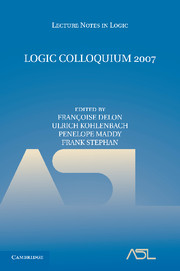Book contents
- Frontmatter
- Contents
- Introduction
- Speakers and Titles
- Decorated linear order types and the theory of concatenation
- Cardinal preserving elementary embeddings
- Proof interpretations and majorizability
- Proof mining in practice
- Cardinal structure under AD
- Three lectures on automatic structures
- Pillay's conjecture and its solution—a survey
- Proof theory and meaning: On the context of deducibility
- Bounded super real closed rings
- Analytic combinatorics of the transfinite: A unifying Tauberian perspective
- References
Proof theory and meaning: On the context of deducibility
Published online by Cambridge University Press: 01 March 2011
- Frontmatter
- Contents
- Introduction
- Speakers and Titles
- Decorated linear order types and the theory of concatenation
- Cardinal preserving elementary embeddings
- Proof interpretations and majorizability
- Proof mining in practice
- Cardinal structure under AD
- Three lectures on automatic structures
- Pillay's conjecture and its solution—a survey
- Proof theory and meaning: On the context of deducibility
- Bounded super real closed rings
- Analytic combinatorics of the transfinite: A unifying Tauberian perspective
- References
- Type
- Chapter
- Information
- Logic Colloquium 2007 , pp. 204 - 219Publisher: Cambridge University PressPrint publication year: 2010
References
- 1
- Cited by



